
Cinematic refers to qualities specific to motion-pictures.
Examples:

Eadweard Muybridge (English-American, 1830-1904),
photographer, Animal Locomotion: Leaping Man, c. 1887,
photographs taken by a series
of cameras. Muybridge
printed these as sheets of sequenced exposures, although they
are displayed here as if projected like a movie — a technological
development Muybridge is considered to have pioneered. Also see Eadweard Muybridge photos reproduced at the "Masters
of Photography" site. See zoopraxiscope.

Louis Lumière (French, 1864-1948),
maker, Feeding the Baby (Repas de bébé),
1895, 35mm film, black and
white, silent, c. 45 seconds, Museum of Modern Art, NY.
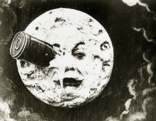
Georges Méliès (French, 1861-1938),
maker, A Trip to the Moon (Le Voyage dans la lune),
1902, 35mm film, black and
white, silent, c. 11 minutes, Museum of Modern Art, NY.
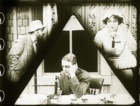
Lois Weber (American, 1882-1939) and Phillips
Smalley (American, 1882-1939), directors, Suspense, 1913, 35mm film, black
and white, silent, c. 12 minutes, Museum of Modern Art, NY.
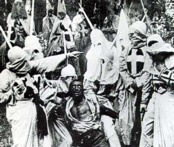
![]()
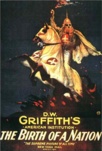
D.W. Griffith (American, 1875-1948), maker, The Birth of a Nation, 1915, 35mm film, black and white and color-tinted, silent, c. 187 minutes. This poster advertised this dramatization of an American Civil War narrative. The Birth of a Nation emphasized a xenophobic portrayal of blacks, and promoted violence against them by the Ku Klux Klan. In the scene from which this still was taken, the "renegade Negro," Gus, played by white actor Walter Long in blackface, is killed following a "trial" conducted by the Klan. Griffith's film was effective propaganda for a revival of the KKK.
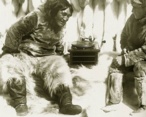
Robert J. Flaherty (American, 1884-1951),
maker, Nanook of the North, 1922, 35mm film,
black and white and color
tinted, silent, c. 56 minutes, Museum of Modern Art, NY.

F. W. Murnau (German, 1889-1931), director,
The Last Laugh (Der letzte Mann), 1924,
35mm film, black and white,
silent, c. 77 minutes, Museum of Modern Art, NY.
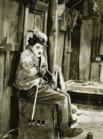
Charles Chaplin (English-American, 1889-1977),
director and actor, The Gold Rush, 1925, 35mm film, black
and white, silent, c. 66 minutes, Museum of Modern Art, NY.
See auteurism.

Sergei Eisenstein (Russian, 1898-1948), director,
Potemkin (Bronenosets Potemkin), 1925,
35mm film, black and white
and hand-colored, silent, c. 75 minutes, Museum of Modern Art,
NY.

Walt Disney (American, 1901-1966), maker,
Steamboat Willie, 1928, 35mm film, black and white, sound, 8
minutes, Museum of Modern Art, NY. See animation.
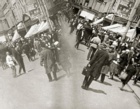
Dziga Vertov (Russian, 1896-1954), maker,
The Man with the Movie Camera (Chelovek S. Kino-apparatom),
1929, 35mm film, black and
white, silent, c. 65 minutes, Museum of Modern Art, NY.
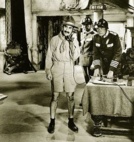
Leo McCarey (American, 1898-1969), director,
Duck Soup, 1933, 35mm film, black
and white, sound, 70 minutes, Museum of Modern Art, NY. The
Marx Brothers, actors.

George Stevens (American, 1904-1975), director,
Swing Time, 1936, 35mm film, black
and white, sound, 103 minutes, Museum of Modern Art, NY.
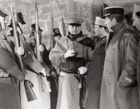
Jean Renoir (French, 1894-1979), director,
Grand Illusion (La Grande Illusion),
1937, 35mm film, black and
white, sound, 93 minutes, Museum of Modern Art, NY.

Orson Welles (American, 1915-1985), director
and actor, Citizen Kane, 1941, 35mm film, black
and white, sound, 119 minutes, Museum of Modern Art, NY.
See auteurism.
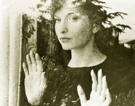
Maya Deren (born Eleanora Derenkovskaya)
(American, born Russia, 1917-1961), maker, Meshes of the Afternoon, 1943, 16mm film,
black and white, silent,
14 minutes, Museum of Modern Art, NY.

Vincente Minnelli (American, 1910-1986),
director, Meet Me in St. Louis, 1944, 35mm film,
color, sound, 113 minutes, Museum of Modern Art, NY. Tom Drake
and Judy Garland, actors.

Yasujiro Ozu (Japanese, 1903-1963), director,
Tokyo Story (Tokyo Monogatari), 1953,
35mm film, black and white,
sound, 135 minutes, Museum of Modern Art, NY. Chiyeko Higashiyama
and Setsuko Hara, actors.
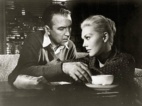
Alfred Hitchcock (English-American, 1899-1980),
director, Vertigo, 1958, 35mm film, color, sound,
128 minutes, Museum of Modern Art, NY. James Stewart and Kim
Novak, actors. See auteurism.

Federico Fellini (Italian, 1920-1993), director,
8 1/2 (Otto e mezzo), 1963, 35mm film,
black and white, sound,
135 minutes, Museum of Modern Art, NY. Marcello Mastroianni,
actor.

Stanley Kubrick (English, 1928-1999), director,
2001: A Space Odyssey, 1968, 35mm film,
color, sound, 137 minutes, Museum of Modern Art, NY. Keir Dullea,
actor.

Stan Brakhage (American, 1933-2003), maker,
The Text of Light, 1974, 16mm film, color,
silent, 68 minutes, Museum of Modern Art, NY.

Martin Scorsese (American, 1942-), director,
Raging Bull, 1980, 35mm film, black
and white and color, sound, 119 minutes, Museum of Modern
Art, NY. Robert De Niro, actor.

Peter
Jackson (New Zealander, 1961-) directer, The Lord of the Rings,
2001-2003, 35mm film, color, sound, a trilogy, based upon the
books by J.R.R. Tolkien, New Line Cinema. There have been numerous
grotesque characters in
literature and theatrical
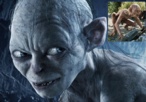 productions.
A significant element in the achievement of this set of films
is the grotesque figure
productions.
A significant element in the achievement of this set of films
is the grotesque figure
Gollum,
who was an entirely digitally
rendered animated character, based upon the acting of Andy Serkis. See tradigital and wireframe.
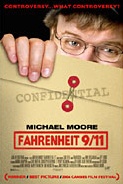

Michael Moore (American, contemporary), director and narrator, Fahrenheit 9/11, 2004, 35 mm film, c. 110 minutes. Moore's Web site called it a "searing examination of the Bush administration's actions in the wake of the tragic events of 9/11." This and others of Moore's movies are often called documentary films. But makers of "documentary" works are generally expected to be as objective as possible, and Moore is unappologetic about shaping his works (by his choice of interviewees, questions to them, narrative, and editing) in supporting his opinions. His films might be called editorialized or diatribes, but they have also been called the P word — propaganda. At least in part, this is because others promote Moore's films to pursuade audiences to take these opinions. Considering the unpleasant connotations attached to the word "propaganda," people who enjoy such works would naturally prefer to categorize Moore's films as documentary rather than propaganda, wishing to give these films the most positive spin possible. Nevertheless, if Fahrenheit 9/11 merits the use of the P word, Michael Moore is apparently rehabilitating it.
 D. Film is focused
on independent films.
D. Film is focused
on independent films.
Also see animation, art careers, cinematic montage, filter, four-dimensional, interdisciplinary, jump cut, kinetic, magic lantern, measure, mobile, movement, music, new media, opaque projector, pan, panning shot, photography, positive, space-time, telephoto, telephoto lens, telephoto shot, tilt, time, tracking shot, video, wide-angle lens, wide-angle shot, zoetrope, zoom, and zoopraxiscope.
https://inform.quest/_art
Copyright © 1996-![]()